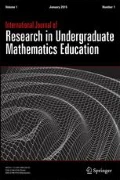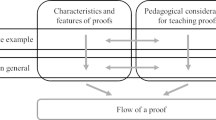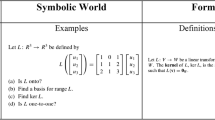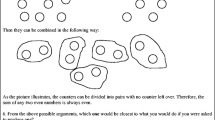Abstract
Over the years, we have noticed our students constructing proofs that commutativity is preserved by isomorphism that do not explicitly use the fact that the isomorphism is surjective. These proofs are typically valid otherwise. However, such proofs are invalid because they would prove the false claim that commutativity is preserved by any homomorphism. This observation from practice raises researchable questions: How common is this phenomenon? What is the nature of this phenomenon and can we explain why students produce this type of argument? In this paper, we report a small-scale two-part survey study and a preliminary interview study designed to begin exploring these questions. Our results suggest that this phenomenon is likely quite common and goes beyond a simple omission of a proof detail. Drawing on the research literature and our follow-up interviews, we propose potential explanations for this phenomenon. Finally, we discuss two different ways to think about supporting students who make this error, one that focuses on refining the students’ proofs and one that involves encouraging students to use the conclusion of a statement to structure a proof.






Similar content being viewed by others
Notes
Survey A and Survey B were shuffled together and handed out to both classes. While we are not claiming this is a fully randomized approach, we can reasonably assume survey distribution does not account for our later results.
Let G and H be isomorphic groups. If a,b in G, then ab = ba implies if c,d in H, then cd = dc.
References
Blair, R. M., Kirkman, E. E., & Maxwell, J. W. (2013). Statistical abstract of undergraduate programs in the mathematical sciences in the United States. Fall 2010 CBMS survey. Providence: American Mathematical Society.
Creswell, J. W. (2014). A concise introduction to mixed methods research. Thousand Oaks: Sage Publications.
Dubinsky, E., & McDonald, M. A. (2002). APOS: A constructivist theory of learning in undergraduate mathematics education research. In D. Holton et al. (Eds.), The teaching and learning of mathematics at university level (pp. 275–282). Dordrecht: Springer Netherlands.
Dubinsky, E., Dautermann, J., Leron, U., & Zazkis, R. (1994). On learning fundamental concepts of group theory. Educational Studies in Mathematics, 27(3), 267–305.
Edwards, B. S., & Ward, M. B. (2004). Surprises from mathematics education research: Student (mis)use of mathematical definitions. The American Mathematical Monthly, 111(5), 411–424.
Harel, G., & Sowder, L. (1998). Students’ proof schemes: Results from exploratory studies. In A. H. Schoenfeld, J. Kaput, & E. Dubinsky (Eds.), Research in collegiate mathematics education, III (pp. 234–283). Providence: American Mathematical Society and Washington, DC: Mathematical Association of America.
Hazzan, O. (1999). Reducing abstraction level when learning abstract algebra concepts. Educational Studies in Mathematics, 40(1), 71–90.
Inglis, M., Mejia-Ramos, J. P., Weber, K., & Alcock, L. (2013). On mathematicians' different standards when evaluating elementary proofs. Topics in Cognitive Science, 5(2), 270–282.
Ioannou, M., & Nardi, E. (2010). Mathematics undergraduates’ experience of visualisation in abstract algebra: The metacognitive need for an explicit demonstration of its significance. In Proceedings of the 13th Conference on Research in Undergraduate Mathematics Education.
Jahnke, H. N. (2008). Theorems that admit exceptions, including a remark on Toulmin. ZDM, 40(3), 363–371.
Lajoie, C., & Mura, R. (2000). What's in a name? A learning difficulty in connection with cyclic groups. For the learning of Mathematics, 20(3), 29–33.
Lakatos, I. (1976). Proofs and refutations. Cambridge: Cambridge University Press.
Larsen, S. (2009). Reinventing the concepts of group and isomorphism: The case of Jessica and Sandra. The Journal of Mathematical Behavior, 28(2–3), 119–137.
Larsen, S., & Zandieh, M. (2008). Proofs and refutations in the undergraduate mathematics classroom. Educational Studies in Mathematics, 67(3), 205–216.
Larsen, S., Johnson, E., & Weber, K. (Eds.). (2013). The teaching abstract algebra for understanding project: Designing and scaling up a curriculum innovation. The Journal of Mathematical Behavior, 32(4), 691–790.
Leron, U., Hazzan, O., & Zazkis, R. (1995). Learning group isomorphism: A crossroads of many concepts. Educational Studies in Mathematics, 29(2), 153–174.
McGowen, M. A., & Tall, D. O. (2010). Metaphor or met-before? The effects of previous experience on practice and theory of learning mathematics. The Journal of Mathematical Behavior, 29(3), 169–179.
Melhuish, K. (2018). Three conceptual replication studies in group theory. Journal for Research in Mathematics Education, 49(1), 9–38.
Melhuish, K., Lew, K., Hicks, M., & Kandasamy, S. (2019). Abstract Algebra Students’ Function-Related Understanding and Activity. In Proceedings of the 22nd Annual Conference on Research in Undergraduate Mathematics Education, Oklahoma City, OK.
Moore, R. C. (1994). Making the transition to formal proof. Educational Studies in Mathematics, 27(3), 249–266.
Oehrtman, M. C., Carlson, M. P., & Thompson, P. W. (2008). Foundational reasoning abilities that promote coherence in students' understandings of function. In M. P. Carlson & C. Rasmussen (Eds.), Making the connection: Research and practice in undergraduate mathematics (pp. 150–171). Washington, DC: Mathematical Association of America.
Rupnow, R. (2017). Students’ conceptions of mappings in abstract algebra. In (Eds.) A. Weinberg, C. Rasmussen, J. Rabin, M. Wawro, and S. Brown, Proceedings of the 20th Annual Conference on Research in Undergraduate Mathematics Education, San Diego, 259–273.
Selden, A., & Selden, J. (1987, July). Errors and misconceptions in college level theorem proving. In Proceedings of the second international seminar on misconceptions and educational strategies in science and mathematics (Vol. 3, pp. 457–470). Ithaca: Cornell University.
Selden, J., & Selden, A. (1995). Unpacking the logic of mathematical statements. Educational Studies in Mathematics, 29(2), 123–151.
Selden, A., & Selden, J. (2003). Validations of proofs considered as texts: Can undergraduates tell whether an argument proves a theorem? Journal for Research in Mathematics Education, 4–36.
Selden, J., & Selden, A. (2015). A perspective for university students’ proof construction. In T. Fukawa-Connelly, N. Infante, K. Keene, & M. Zandieh (Eds.), Proceedings of the 18th annual conference on research in mathematics education (pp. 22–36). Pittsburgh: SIGMAA on RUME.
Selden, A., McKee, K., & Selden, J. (2010). Affect, behavioral schemas and the proving process. International Journal of Mathematical Education in Science and Technology, 41(2), 199–215.
Sinclair, N., Watson, A., Zazkis, R., & Mason, J. (2011). The structuring of personal example spaces. The Journal of Mathematical Behavior, 30(4), 291–303.
Stylianides, G. J., Stylianides, A. J., & Weber, K. (2017). Research on the teaching and learning of proof: Taking stock and moving forward. In J. Cai (Ed.), Compendium for Research in Mathematics Education. Reston: National Council of Teachers of Mathematics.
Swinyard, C., & Larsen, S. (2012). Coming to understand the formal definition of limit: Insights gained from engaging students in reinvention. Journal for Research in Mathematics Education, 43(4), 465–493.
Weber, K. (2001). Student difficulty in constructing proofs: The need for strategic knowledge. Educational Studies in Mathematics, 48(1), 101–119.
Weber, K., & Alcock, L. (2004). Semantic and syntactic proof productions. Educational Studies in Mathematics, 56(2–3), 209–234.
Zandieh, M., Roh, K. H., & Knapp, J. (2014). Conceptual blending: Student reasoning when proving “conditional implies conditional” statements. The Journal of Mathematical Behavior, 33, 209–229.
Author information
Authors and Affiliations
Corresponding author
Ethics declarations
Conflict of Interest
On behalf of all authors, the corresponding author states that there is no conflict of interest.
Additional information
Publisher’s Note
Springer Nature remains neutral with regard to jurisdictional claims in published maps and institutional affiliations.
Rights and permissions
About this article
Cite this article
Melhuish, K., Larsen, S. & Cook, S. When Students Prove a Theorem without Explicitly Using a Necessary Condition: Digging into a Subtle Problem from Practice. Int. J. Res. Undergrad. Math. Ed. 5, 205–227 (2019). https://doi.org/10.1007/s40753-019-00090-9
Published:
Issue Date:
DOI: https://doi.org/10.1007/s40753-019-00090-9




